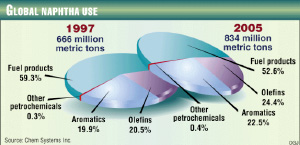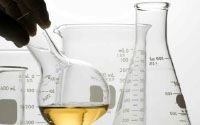 Petroleum naphtha is an intermediate hydrocarbon liquid stream derived from the refining of crude oil. It is most usually desulfurized and then catalytically reformed, which re-arranges or re-structures the hydrocarbon molecules in the naphtha as well as breaking some of the molecules into smaller molecules to produce a high-octane component of gasoline (or petrol).
Petroleum naphtha is an intermediate hydrocarbon liquid stream derived from the refining of crude oil. It is most usually desulfurized and then catalytically reformed, which re-arranges or re-structures the hydrocarbon molecules in the naphtha as well as breaking some of the molecules into smaller molecules to produce a high-octane component of gasoline (or petrol).
The first unit process in a petroleum refinery is the crude oil distillation unit. The overhead liquid distillate from that unit is called virgin or straight-run naphtha and that distillate is the largest source of naphtha in most petroleum refineries. The naphtha is a mixture of very many different hydrocarbon compounds. It has an initial boiling point (IBP) of about 35 °C and a final boiling point (FBP) of about 200 °C, and it contains paraffin, naphthene (cyclic paraffins) and aromatic hydrocarbons ranging from those containing 4 carbon atoms to those containing about 10 or 11 carbon atoms.
It is the virgin heavy naphtha that is usually processed in a catalytic reformer because the light naphtha has molecules with 6 or less carbon atoms which, when reformed, tend to crack into butane and lower molecular weight hydrocarbons which are not useful as high-octane gasoline blending components. Also, the molecules with 6 carbon atoms tend to form aromatics which is undesirable because governmental environmental regulations in a number of countries limit the amount of aromatics (most particularly benzene) that gasoline may contain.
APLICATION
 Naphtha is used primarily as feedstock for producing high octane gasoline (via the catalytic reforming process). It is also used in the bitumen mining industry as a diluent, the petrochemical industry for producing olefins in steam crackers, and the chemical industry for solvent (cleaning) applications
Naphtha is used primarily as feedstock for producing high octane gasoline (via the catalytic reforming process). It is also used in the bitumen mining industry as a diluent, the petrochemical industry for producing olefins in steam crackers, and the chemical industry for solvent (cleaning) applications